
Jump to:
Sukiyaki holds a special place in the pantheon of Japanese cuisine.
It’s long been known in the US and around the world as a staple of Japanese cooking – along with sushi, tempura and (more recently) ramen.
Not just an item on a menu, sukiyaki is an immersive culinary experience that involves cooking at the table, sharing among friends & family and savoring every bite of a beautifully layered dish. While it can be found at restaurants throughout Japan, sukiyaki is most often enjoyed at home.
Sukiyaki is a melting pot of select prime-cut beef, crisp, seasonal vegetables, delicate tofu, and savory noodles, all simmered in a sweet and silky sukiyaki broth.
Let’s explore the world of sukiyaki, from its humble origins and regional differences to its essential ingredients and times & places of enjoyment.
What Is Sukiyaki?

Sukiyaki is a form of Japanese hot pot, or "nabe" dish, characterized by a communal ‘cook at the table’ approach. A sukiyaki pot, often a traditional cast-iron or stainless steel pan, serves as the center of this shared dining process, its simmering contents emanating appetizing aromas amidst a steam of goodness.
Sukiyaki is indeed a delicious gateway into the homey comforts of Japanese cuisine for food enthusiasts who visit Japan and/or who want to recreate a Japanese meal at home.
Sukiyaki Ingredients
As is the case for nearly all “washoku” or Japanese cuisine, sukiyaki offers a well-balanced mixture of proteins, vegetables and noodles.
Thinly sliced beef – typically Wagyu, acclaimed for its exceptional marbling and buttery softness – is the star of the dish. If you’re making sukiyaki at home (more on this later) and don’t have access to Wagyu, you can substitute beef from your local butcher or supermarket.
Accompanying the meat (or in place of it, for vegans and vegetarians) is tofu, with its velvety texture and heartiness. A variety of mushrooms (e.g. shiitake, enoki and/or kinoko) lend an earthy depth to the mix. Not to be forgotten are the vibrant dashes of color and crunch provided by green onions and Japanese cabbage. Balancing the color spectrum is the yellow from eggs, which are served raw in a side dish and used for dipping the meat and other ingredients.
(Note: While raw eggs are safe to consume in Japan due to strict regulations about how eggs are raised and treated, this may differ from country to country; please adhere to the health and safety guidelines of your locality and do not eat raw eggs if deemed inadvisable)
Immersed in a delectable sukiyaki broth composed of soy sauce, sugar and sake, these ingredients blend together to form a spectrum of flavors and textures in an iconic Japanese dish. With a sweetness that subtly complements the savory elements, the sukiyaki broth (started with a sauce called "tare”) cascades over the ingredients as it bubbles in the cauldron, infusing the meat and vegetables with a balanced but succulent richness.
The umami of the sukiyaki broth, the tenderness of the Wagyu and the freshness of the vegetables all converge in a time-honored culinary experience.
Now that we've introduced sukiyaki itself, it's time to delve into the story woven into this dish's existence: Its history.
The History Of Sukiyaki

The origins of sukiyaki trace back to the Meiji Era (1868-1912), a period when Japan reopened to the world after centuries of isolation. As Western culture started to have more influence in Japan, consumption of beef became more common.
Over time, sukiyaki became a popular choice for year-end parties, locally known as bonenkai, and gatherings of families and/or friends, given its communal and participatory cooking nature. However, sukiyaki's journey wasn't always one of widespread joy.
The hard times during and after World War II led to a shortage of high-quality beef, causing sukiyaki to fade into the background for some time. Thankfully Japan soon began to experience economic prosperity in the post-war years, and sukiyaki sprung back into popularity, attaining its special place in the Japanese culinary realm.
Two Regions, Two Distinct Styles: Kanto vs Kansai Style Sukiyaki
As sukiyaki evolved through time and across Japan, it branched out into various regional interpretations, distinguishing mainly into Kanto and Kansai styles. Though sharing the fundamental elements of sukiyaki broth and assorted ingredients, the Kanto and Kansai styles differ in their cooking process, specifically the usage of the sukiyaki broth or sauce.
Kanto-Style Sukiyaki

Originating from Tokyo and the Kanto region, this method involves preparing the sukiyaki broth – a sweet and savory blend of soy sauce, sugar and sake – in advance and cooking all of the ingredients directly in this flavorful mixture. The resulting sukiyaki has a robust taste, permeated with umami throughout every element of the dish. The Kanto-style method ensures an intense and consistent seasoning with every bite. Want to learn how to make it? Check out our recipe!
Kansai-Style Sukiyaki

Hailing from the Kansai region, including cities like Osaka and Kyoto, the Kansai-style sukiyaki involves a different cooking approach. The meat is first grilled in the pot with a bit of rendered beef fat and sugar, seasoned with soy sauce – this adds an air of anticipation as the smell of browning wagyu beef permeates the room. Only after this, the rest of the vegetables are added, and sake is poured into the pot for simmering. The emphasis in this method is on appreciating the original flavors of the ingredients, as the sukiyaki broth here serves as more of an accent as opposed to being a dominant feature.
Aside from the differences in flavor and preparation, you might hear a difference in the way Japanese people pronounce “sukiyaki,” depending on region. In Tokyo, which is widely considered to speak “standard” Japanese dialect (save for people who live in the capital but hail from elsewhere in Japan), the “U” is rather silent, pronounced more like “skee-yah-kee.” In Kansai, you might hear the “U” pronounced just a bit more noticeably. Regardless, each region’s version of sukiyaki is bound to be delicious!
How To Make & Eat Sukiyaki

Beyond its delectable flavors, part of sukiyaki's charm lies in its unique serving and eating style. Sukiyaki is traditionally cooked at the table on a portable gas stove. This social, participatory style brings friends and family together, fostering a warm sense of community.
We’ve got a recipe for Kansai-style sukiyaki that’s worth giving a go at home! The following ingredients and gear will get you started on your sukiyaki cooking venture.
- Iwachu Sukiyaki Pot Large Size Japanese Cast Iron Pan 26cm
- Miyamura Shibata Fu Japanese Dried Wheat Gluten 10 pcs.
- Kikkoman Mature Aged Warishita Sukiyaki Sauce 500ml,
- Malony Dried Starch Thick Japanese Noodles 100g
- Daishin Stainless Steel Japanese Chopsticks 245mm
Essentials for Making Sukiyaki
Vegetarians and vegans will want to skip right to the tofu, but meat lovers should take care in choosing the best beef for sukiyaki. Wagyu is the ideal beef for sukiyaki, of course; and among the Wagyu range, A5 is prized. If that’s out of reach, beef from the local butcher or supermarket will do fine – just make sure to select cuts with higher fat content and fine marbling, such as chuck eye roll or ribeye (and ask for it to be sliced very thinly).
As for the tofu, a firm one is better; and if you’ve got the equipment, give the top of the tofu a lightly torched coating for a smoky effect.
Vegetables can include a wide range of options, depending on what’s available and what you like. Traditional sukiyaki incorporates green onions, napa cabbage and mushrooms (shiitake and enoki are great; kinoko or shimeji will work fine as well). You can add or swap for carrots, spinach, eggplant, beansprouts and/or a wide range of vegetables. Optional but highly recommended are noodles; some people opt for a noodle-looking form of konjac.
All set to go, right? Wait! What about the sukiyaki broth? Yes, before cooking, make sure you’ve got “tare” on hand. Follow the instructions on the bottle to mix in water in the proper ratio, ensuring a superior and tasty broth – an essential part of any sukiyaki experience. Depending on personal preference, one can adjust the sweetness or saltiness of the sukiyaki broth, though we recommend starting with the suggested ratio as a baseline and adjusting to taste after that.
Start the Pot
The ingredients are cooked piece by piece at the table. Depending on the style, you might start with beef or with the sauce. It’s all cooked in the sukiyaki broth itself, remember… unless:
Going Kansai style? Brown some of the beef in the pot first, along with a piece of fat, then start adding in the vegetables. Once the meat is browned, add the “tare” plus water, and continue to layer the sukiyaki.
Regardless of Kanto or Kansai style, sukiyaki is a slower, drawn-out experience. Don’t cook it all at once! Instead, keep a good supply of both protein and vegetables available to cook when everyone is ready for more.
Cook and Dip
Upon being cooked, the ingredients are taken from the pot, dipped into the raw egg (if/where possible), and savored while still hot.
Places To Try Sukiyaki In Japan

Japan hosts an impressive array of restaurants specializing in sukiyaki. If you're in Japan and have the opportunity, consider visiting these highly-regarded establishments for an unbeatable sukiyaki experience:
Based in Tokyo, Imahan boasts a reputation for superb sukiyaki since 1895, particularly celebrated for its use of quality Wagyu beef. With locations in Kyoto and Tokyo, Moritaya excels in providing customers with delicate sukiyaki with unforgettable experiences. Kyoto’s Mishima-tei is also known for tender, flavorsome sukiyaki.
While these are just a few examples, numerous restaurants across Japan serve delectable sukiyaki. Even better, if you’re ever invited to someone’s home for a sukiyaki dinner, definitely jump at the opportunity!
A home-cooked sukiyaki meal is an experience you’ll never forget, sharing a communal meal with friends old and new. No invitation? Maybe mention casually how you’ve heard of sukiyaki and are looking to try it – worst case scenario, you’ll get some restaurant recommendations; and you might just receive an invitation to a special experience!
Sukiyaki vs Shabu-Shabu: Similarities & Differences

With all this talk of beef cooked in hot liquid and dipped before eating, you might also be thinking about another famous Japanese dish: shabu-shabu.
Shabu-shabu is similar to sukiyaki in that it is a table-cooked dish made with Wagyu or well-marbled prime cuts of beef that are thinly sliced. Shabu-shabu is then cooked in boiling hot liquid and dipped – but both the cauldron and the dipping elements are different.
While sukiyaki is cooked in sweet-and-salty broth with tofu and vegetables, shabu-shabu is cooked either in boiling water, or in a much lighter broth that has savory hints but nothing that would overpower the beef. Shabu-shabu beef is generally sliced more thinly, and is only submerged in the broth for a short time before being taken out. The beef is then dipped quickly in a sauce of ponzu or sesame, among other varieties.
Both dishes are a unique experience to Japanese cuisine, and each has its merits. Sukiyaki allows some leeway for vegetarians and vegans, but shabu-shabu is really more about fine beef than the full spectrum experience.
Other Hot Pot Dishes in Japan
Other than sukiyaki and shabu-shabu, two other dishes stand out in Japan’s hot pot game.
“Nabe” is a generic term for pot, and also denotes hot pot. If someone says they are serving nabe at home, they typically are referring to a dish that is similar to sukiyaki but lighter in flavor – and offers a wider range of ingredients, from chicken and pork to seafood and more. Tofu is a stalwart feature in nabe, and seasonal vegetables are a must. The type of nabe can vary by region as well as by season – there’s even a special nabe for sumo!
Oden is a favorite among Japanese people, particularly in the wintertime. Oden is less of a hot pot and more of a stew, with hearty ingredients such as seafood and tofu, among others. This stew is eaten both at home and in restaurants – even Japan’s lauded konbini (convenience stores) have oden on offer in the wintertime.
Sukiyaki: A Longstanding Tradition in Japanese Cuisine

Whether you’re enjoying it at a restaurant or home in Japan, or recreating it at home for yourself, sukiyaki is an essential Japanese dish that’s not to be missed.
From the sweet and savory sukiyaki broth, to the finely marbled Wagyu, to the fresh vegetables, sukiyaki is a culinary delight. Beyond the food itself, sukiyaki is an occasion to share a meal among friends and family, cooking slowly and eating from a communal pot at the table.
You’ll never forget your first sukiyaki, and you’ll surely want to experience it again whenever the opportunity presents itself.


0 comments